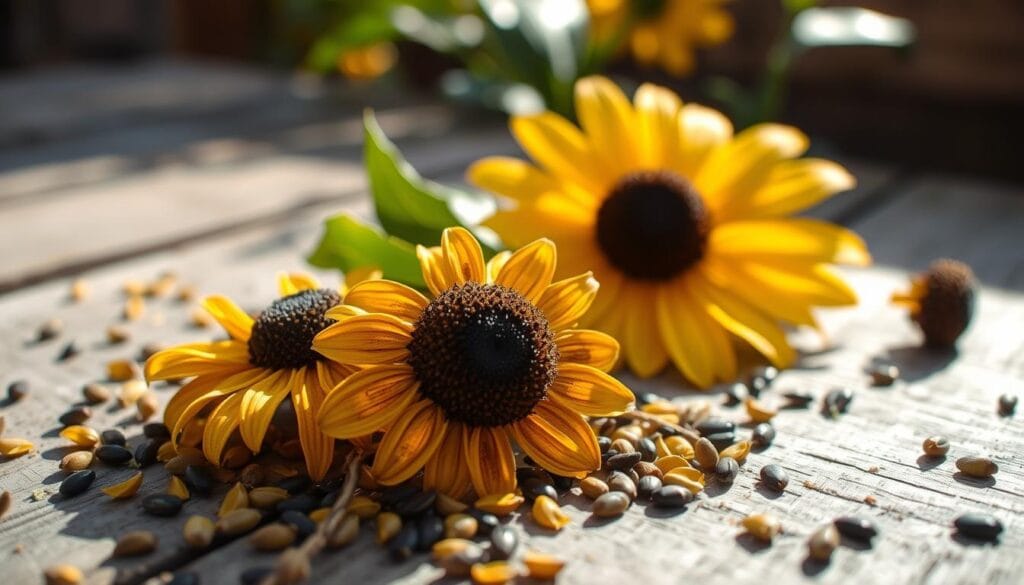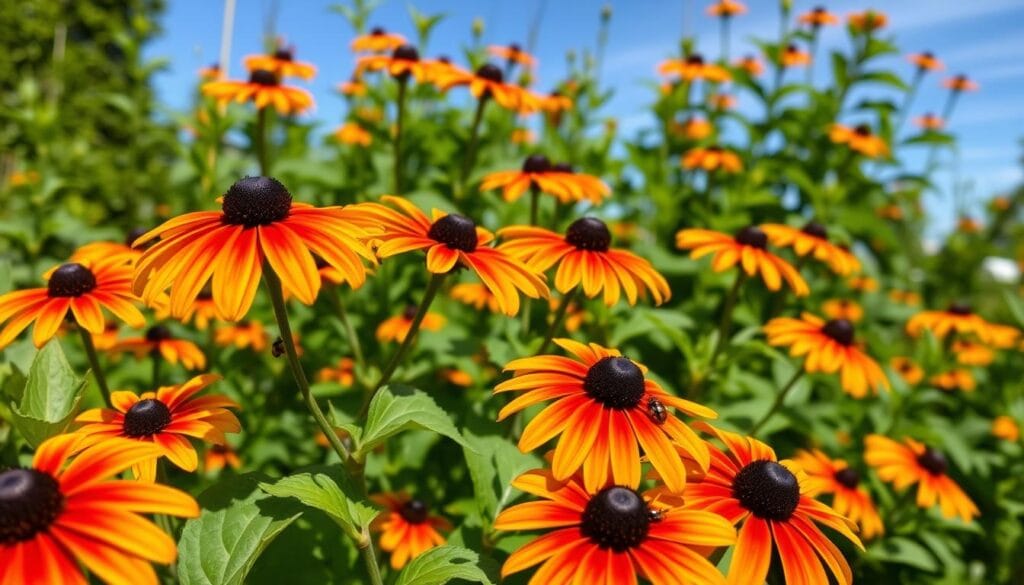Did you know the black-eyed Susan is a native wildflower of North America with 25 species1? This makes the Rudbeckia genus a great choice for gardeners in the United States. It can turn your garden into a lively spot that draws pollinators and birds.
Black-eyed Susans are not just beautiful; they’re also tough. They grow well in zones 3 through 9, fitting many climates21. They’re easy to care for and can handle dry spells, making them ideal for all gardeners3.
One of the best things about black-eyed Susans is how long they bloom. They light up our gardens from June to August. Some varieties even bloom in mid-spring and keep going until the first frost21. Imagine having a garden full of golden colors for months!
Exploring Rudbeckia, I’m always impressed by its flexibility. These plants can be small, perfect for borders, or tall, making a big statement1. They come in different sizes and colors, from bright yellow to orange-gold, fitting every garden style1.
Key Takeaways
- Black-eyed Susans are native to North America with 25 species
- They thrive in zones 3-9, adapting to various climates
- These flowers are low-maintenance and drought-tolerant
- Bloom time typically spans from June to August, with some varieties lasting longer
- Plant heights range from 10 inches to 7 feet, suiting various garden designs
- Black-eyed Susans attract pollinators and birds, enhancing garden biodiversity
Introduction to Black-Eyed Susan (Rudbeckia)
Black-Eyed Susan, also known as Rudbeckia, is a favorite in North American gardens. Its bright golden petals and dark centers light up any space. It’s loved by gardeners and pollinators for its beauty and adaptability.
Native Wildflower Characteristics
Rudbeckia hirta, or the common Black-Eyed Susan, grows well in many places. It’s found mainly in the eastern half of North America. Its life cycle changes based on where it grows, making it interesting for garden lovers4.
Benefits for Pollinators and Wildlife
Black-Eyed Susan is great for attracting pollinators like bees and butterflies. It also draws beetles4. Planting it in groups can really boost pollinator activity in your garden5.
Varieties and Species Overview
The Rudbeckia family has many varieties to choose from. There’s the ‘American Gold Rush’ that’s 22 to 27 inches tall, and the ‘Herbsonne’ that can grow up to 7 feet5. Some popular ones include:
- ‘Autumn Colors’ with its gold to orange to brown petals
- ‘Cherry Brandy’ with its red to maroon colors
- ‘Forever Gold’ with its yellow flowers on small plants
Whether you want a biennial like Rudbeckia hirta or a perennial like Sweet Black-eyed Susan (Rudbeckia subtomentosa), there’s a Rudbeckia for every garden6.
Ideal Growing Conditions for Black-Eyed Susan
Black-eyed Susans are versatile plants that thrive in various settings. They adapt well to different environments, making them a popular choice for gardeners across the United States.
Sunlight Requirements
These cheerful flowers love basking in full sun. They grow best when exposed to direct sunlight for most of the day. In my experience, planting them in a spot that receives at least 6 hours of sunlight daily yields the best results7.
Soil Preferences
Black-eyed Susans aren’t picky about soil, but they do have some preferences. I’ve had success growing them in well-draining soil with a neutral pH. They can tolerate various soil types, even clay-heavy soils8. To ensure optimal growth, I mix in some organic matter before planting.
Climate and Hardiness Zones
These hardy plants are quite adaptable to different climates. They’re suitable for USDA hardiness zones 3 through 9, making them a great choice for many regions across the country7. Black-eyed Susans thrive in warmer temperatures, typically above 60°F7.
| Factor | Ideal Condition |
|---|---|
| Sunlight | Full sun (6+ hours daily) |
| Soil | Well-draining, neutral pH |
| Hardiness Zones | USDA 3-9 |
| Temperature | Above 60°F |
I’ve noticed that Black-eyed Susans are quite resilient. They can withstand drought and humidity, though good air circulation helps prevent fungal issues7. Their adaptability to various conditions, including salty soils, makes them a reliable choice for diverse garden settings8.
Planting Black-Eyed Susan
I love planting Black-Eyed Susans in my garden. These cheerful flowers offer a variety of planting techniques. Whether you’re a fan of seed sowing or prefer transplanting, there’s a method for you.
For seed sowing enthusiasts, I recommend starting indoors or directly in the garden. If sowing outdoors, wait until the soil temperature reaches about 70°F for best results8. Sprinkle the seeds on top of the soil, as they need light to germinate. Expect germination in 7 to 21 days7.
When transplanting, I dig a hole slightly wider than the root ball. Space plants 18-30 inches apart for larger cultivars, or 6-12 inches for dwarf varieties7. After placing the plant, I backfill and water thoroughly.
“Black-Eyed Susans are nature’s way of bringing sunshine to your garden. They’re easy to grow and a joy to behold!”
Here’s a handy table summarizing the planting techniques:
| Technique | Best Time | Method |
|---|---|---|
| Seed Sowing (Outdoors) | Spring or Fall | Sprinkle on soil surface |
| Seed Sowing (Indoors) | 6 weeks before last frost | Use starter trays |
| Transplanting | Spring or Fall | Dig hole, place plant, backfill |
Remember, Black-Eyed Susans are prolific self-seeders. They’ll spread over time, ensuring fresh blooms even if the mother plant doesn’t survive winter9. This makes them a fantastic choice for gardeners looking for low-maintenance, long-lasting beauty in their landscapes.
Watering and Fertilization Tips
Black-Eyed Susans are easy to care for. They grow well in many soils, making them a pleasure to tend. Let’s explore how to keep these vibrant flowers blooming in your garden.
Moisture Needs
Black-Eyed Susans don’t need much water. They like a regular watering schedule when they’re young. As they grow, they can handle dry spells well. But, they don’t like to be too wet.
Before watering, check the soil. If it’s dry an inch down, it’s time to water.
Fertilizer Recommendations
These plants do well in poor soils, from clay to sand10. A little organic fertilizer can help them grow. I use a slow-release fertilizer in early spring when they start growing10.
This gives them nutrients all season.
| Fertilizer Type | Application Time | Frequency |
|---|---|---|
| Slow-release granular | Early spring | Annually |
| Organic compost | Fall | Annually |
Drought Tolerance
Black-Eyed Susans are great at handling dry weather. They’re perfect for gardens that save water. But, they don’t like being too wet, as it can cause crown rot11.
To avoid this, make sure the soil drains well and don’t overwater.
Even though they’re good at surviving without water, they do best with regular care. With the right watering and fertilizing, you’ll enjoy their bright yellow flowers all summer.
Pruning and Maintenance
I love taking care of my Black-Eyed Susans. Pruning is a big part of that. It helps make the stems stronger, so they don’t need staking12. Let’s look at some important deadheading and winter care tips.
Deadheading is key for these flowers. It keeps them blooming longer and stops diseases12. It’s amazing how a simple action can make such a big difference! For the annual types, I let them self-seed for new plants in spring13.
Timing is everything when pruning. Cutting back in late spring makes them bushier and more flower-filled in summer12. I also prune to improve air flow, which fights off mildews and rusts12.
“Proper pruning is like giving your Black-Eyed Susans a spa day – it rejuvenates them and keeps them looking their best!”
Winter care is also vital. In colder areas, I clean up at the end of the season to help them survive12. But, Black-Eyed Susans are often seen as biennials, living only two years before seeding and dying13.
| Maintenance Task | Frequency | Benefits |
|---|---|---|
| Deadheading | Throughout summer | Longer blooming, disease prevention |
| Pruning | Late spring | Bushier plants, more flowers |
| Winter clean-up | Fall or early spring | Improved cold hardiness |
Remember, these fast-growing perennials are drought-tolerant. They need about 1/2 – 1 inch of water per week for best growth13. With these tips, your Black-Eyed Susans will do great year after year!
Propagation Methods
I love exploring different ways to grow Black-Eyed Susan. These flowers are easy to spread in your garden. Let’s look at the best ways to grow more of these bright blooms.
Seed Collection and Sowing
Seed saving is a fun way to grow Rudbeckia. I collect seeds from dried flowers in late autumn, from September to November14. Then, I store them in a cool, dry spot.
When spring comes, I sow them indoors 6-8 weeks before the last frost. Rudbeckia seeds germinate in 14 to 21 days14.

Division Techniques
Plant division is a good way to grow perennial Rudbeckia. I divide my plants every 3-4 years in spring or fall15. This means digging up the plant, separating the roots, and replanting.
It’s a great way to make new plants from old ones for free!
Stem Cuttings
Stem cuttings are a quick way to grow more plants. In summer, I take 6-8 inch cuttings from healthy stems. Then, I remove lower leaves and put them in water to root.
Once roots grow, I transplant them into rich soil that keeps water well14.
| Propagation Method | Best Time | Success Rate | Difficulty Level |
|---|---|---|---|
| Seed Saving | Fall collection, Spring sowing | High | Easy |
| Plant Division | Spring or Fall | Very High | Moderate |
| Stem Cuttings | Summer | Moderate | Easy |
Learning these methods will help you fill your garden with Black-Eyed Susans. Some Rudbeckia species can grow up to 9 feet tall16. So, plan your garden layout carefully.
Companion Plants for Black-Eyed Susan
I love making my garden look beautiful with different plants. Black-Eyed Susans are great because they go well with many others. Let’s find some plants that will make your garden even better.
Planting Purple Coneflowers (Echinacea purpurea) with Black-Eyed Susans is a great idea. Their colors look amazing together. Russian Sage (Perovskia atriplicifolia) adds a nice, soft look and a lovely lavender color17.
Ornamental grasses like Switchgrass (Panicum virgatum) or Little Bluestem (Schizachyrium scoparium) add movement and shape. They look great swaying in the wind next to Black-Eyed Susans17.
For a garden that attracts pollinators, add Agastache, Salvia, or Yarrow. These plants are good friends to Black-Eyed Susans and help attract helpful insects17. In dry spots, Rudbeckia triloba is a good choice because it looks similar18.
Want to try out different colors? Plant annuals like Marigolds, Cosmos, or Nasturtiums with your Black-Eyed Susans. This way, you can see how different colors work before spending a lot on perennials17.
For a garden that looks natural, mix Black-Eyed Susans with native plants. Try Butterfly Weed (Asclepias tuberosa), Tall Tickseed (Coreopsis tripteris), and Prairie Dropseed (Sporobolus heterolepis)18. These plants make a beautiful, easy-to-care-for garden that helps local wildlife.
When planning your garden, think about how big your plants will get. Most Black-Eyed Susans grow 2-3 feet tall and spread 1-2 feet wide18. Knowing this helps you arrange your plants in a way that looks good and is balanced.
Common Pests and Diseases
Growing Black-Eyed Susan (Rudbeckia) is rewarding but requires vigilance against diseases and pests. As an organic gardening enthusiast, I’ve found that knowing common issues helps with effective pest control.
Fungal Problems
Fungal diseases often affect Rudbeckia. Powdery mildew, caused by Phyllactinia and Golovinomyces, can cause yellowing and early leaf drop19. Downy mildew shows as dark blotchy areas on upper leaf surfaces, while fungal leaf spots spread in wet conditions19.
Insect Invaders
Aphids are sap-sucking pests that coat leaves with honeydew, while goldenglow sawfly larvae can defoliate plants20. The four-lined plant bug causes round, brown, sunken spots on leaves, impacting plant health20.

Prevention and Treatment
To prevent issues, ensure good air circulation and avoid overhead watering. For organic pest control, I remove severely affected plants to stop disease spread. In late summer, watch for powdery mildew’s white, powdery growth on leaves20. For fungal problems, I use organic fungicides as a last resort.
Remember, healthy plants resist diseases better. Space Rudbeckia 12 to 18 inches apart to promote air flow20. By following these tips, you’ll enjoy thriving Black-Eyed Susans in your garden.
Black-Eyed Susan (Rudbeckia) in Landscape Design
I love using Black-Eyed Susan in garden design. This native North American flower blooms from June to October. That’s a whopping 4-month display of color21! It’s no wonder these beauties are a top pick for native plant landscaping and wildflower gardens.
In my experience, Black-Eyed Susans are incredibly versatile. They thrive in zones 3 through 9, making them suitable for a wide range of climates1. I often use them in borders, beds, and even containers. The ‘Little Goldstar’ variety, growing just 14 to 16 inches tall, is perfect for urban gardens with limited space1. For a dramatic backdrop, I’ll plant the ‘Herbstsonne’ variety, which can reach an impressive 7 feet in height1!
When planning a landscape, I consider the environmental benefits of Black-Eyed Susans. They attract a variety of pollinators, including bees, butterflies, and even flies8. Plus, they provide food for birds in fall and winter21. I’ve found that incorporating these flowers can boost property value and even help reduce heating and cooling costs21. It’s a win-win for both aesthetics and eco-friendliness in any garden design.
To keep Black-Eyed Susans looking their best, I water them deeply once a week during dry spells. After the first frost, I prune them back to about 2 inches above the ground21. With minimal care, these hardy plants reward me with a stunning display that enhances any landscape design, from formal perennial borders to naturalized meadow gardens.
FAQ
What are the characteristics of black-eyed Susan (Rudbeckia)?
What are the benefits of black-eyed Susan for pollinators and wildlife?
What are some popular varieties of black-eyed Susan?
What are the sunlight requirements for black-eyed Susan?
What type of soil does black-eyed Susan prefer?
How do I plant black-eyed Susan from seeds?
How do I water and fertilize black-eyed Susan?
How do I propagate black-eyed Susan?
What are some common pests and diseases affecting black-eyed Susan?
How can I incorporate black-eyed Susan in landscape design?
Source Links
- Black-Eyed Susan: A Growing Guide for Rudbeckia – Garden Design
- How to Grow Black-eyed Susans: The Complete Black-eyed Susan Flower Guide
- Grow Black-Eyed Susan for Beautiful Yellow Summer Flowers
- Black-eyed Susan (Rudbeckia hirta) – bplant.org
- Black-Eyed Susan: Beautiful and Beneficial
- Rudbeckia hirta
- Black-Eyed Susans: Plant Care & Growing Guide
- How to Grow Black-Eyed Susan Flowers (Rudbeckia Hirta)
- How to Grow and Care for Black-Eyed Susans, Vibrant Self-Seeders That You Can Plant in the Fall
- Fertilizing Black-Eyed Susans | Plant Addicts
- Black-Eyed Susan Grow Guide
- Pruning Black-Eyed Susans | Plant Addicts
- Black-Eyed Susan Care | Plant Addicts
- Planting rudbeckia: how to grow black-eyed Susans – Plantura
- How To Propagate Rudbeckia From Seeds And Root Division, + Common Growing Mistakes to Avoid
- Growing Rudbeckia: How to Plant, Grow, and Care For Black-Eyed Susans
- Black-Eyed Susan Companion Plants | Plant Addicts
- Rudbeckia hirta Sweet black-eyed Susan from New Moon Nurseries
- Rudbeckia Diseases
- FPS512/FP512: Rudbeckia hirta Blackeyed Susan, Gloriosa Daisy
- Introduction to Landscaping with Black Eyed Susan | Blog | Arbor Valley Nursery


